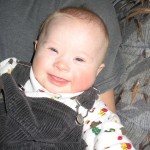¨ Down syndrome was discovered by Dr. Langdon Down in 1866.
¨ Down syndrome is a naturally occurring chromosomal arrangement.
¨ Down syndrome is the most commonly occurring chromosomal condition.
¨ It is a chromosomal anomaly, or mix-up, in the genetic blue-print that occurs at conception.
¨ The individual has three, rather than two, copies of chromosome 21 –thus the medical term – Trisomy 21.
¨ Down syndrome occurs when an individual has a full or partial extra copy of chromosome 21. This additional genetic material alters the course of development and causes the characteristics associated with Down syndrome.
¨ There are three types of Down syndrome: trisomy 21 (nondisjunction) accounts for 95% of cases, translocation accounts for about 4% and mosaicism accounts for about 1%.
¨ It affects all races and genders equally.
¨ The incidence of births of children with Down syndrome increases with the age of the mother. But due to higher fertility rates in younger women, 80% of children with Down syndrome are born to women under 35 years of age.
¨ One in every 800 babies has Down syndrome.
¨ A few of the common physical traits of Down syndrome are low muscle tone, small stature, almond-shaped eyes, and a single deep crease across the center of the palm and small facial features. Every person with Down syndrome is a unique individual and may possess these characteristics to different degrees or not at all.
¨ People with Down syndrome have some physical, intellectual and emotional developmental delays.
¨ People with Down syndrome have an increased risk for certain medical conditions such as congenital heart defects, respiratory and hearing problems, vision issues or hypothyroidism. No one will have all of the medical issues however good preventative care is needed. Teamwork between family members and doctors is important to anticipate any issues and treatments should it be needed. Appropriate health care can enhance the potential of individuals with Down syndrome.
¨ All people with Down syndrome experience cognitive delays, but the effect is usually mild to moderate and is not indicative of the many strengths and talents that each individual possesses.
¨ Quality educational programs, a stimulating home environment, good health care, and positive support from family, friends and the community enable people with Down syndrome to develop their full potential and lead fulfilling lives.
¨ People with Down syndrome attend school, work, participate in decisions that affect them, and contribute to society in many wonderful ways.
¨ Life expectancy for people with Down syndrome has increased dramatically in recent decades – from 25 in 1983 to 60 today.
Children with Down syndrome share more similarities than differences with other children. They learn, laugh, play and want friends just like all children.
Individuals with Down syndrome benefit from loving parents, families, early medical and educational attention and positive public attitudes.
Early intervention, through parents and IDP workers, benefit a child with Down syndrome, as do speech and language therapy, occupational therapy and physical therapy.
Children with Down syndrome have a full complement of emotions and attitudes, are creative and imaginative in play and pranks, and grow up to live independent lives with varying degrees of support and accommodations needed.
On standard IQ tests, children with Down syndrome most often score in the mild to moderate range of developmental disabilities. These tests do not measure many important areas of intelligence, and one will often be surprised by the memory, insight, creativity, and cleverness of the child with Down syndrome.
Academic intelligence is not the only measure of a person’s worth. To help break through social and personal prejudices, qualities such as happiness, honesty, friendliness, determination and a free-spirited attitude to life opens doors to full membership in society.
Thousands of young people with Down syndrome across the country are quietly going on with their lives and transforming their communities by just being there. They have dreams and the determination to reach their goals. They learn in regular classrooms in their neighborhood schools with the children who will one day be their co-workers, neighbors and adult friends. Young adults hold diverse and meaningful jobs, maintain their own households and make significant contributions to their communities.


